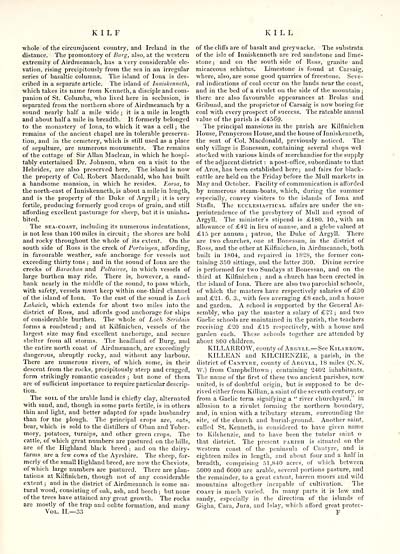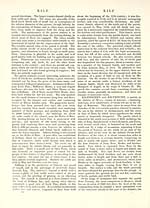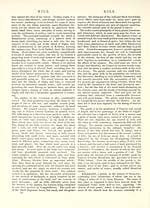Topographical dictionary of Scotland > Volume 2
(41) Page 33
Download files
Complete book:
Individual page:
Thumbnail gallery: Grid view | List view

K I L F
KILL
whole of the circumjacent country, and Ireland in the
distance. The promontory of Burg, also, at the western
extremity of Airdmeanach, has a very considerable ele-
vation, rising precipitously from the sea in an irregular
series of basaltic columns. The island of Iona is des-
cribed in a separate article. The island of Inniskenneth,
which takes its name from Kenneth, a disciple and com-
panion of St. Columba, who lived here in seclusion, is
separated from the northern shore of Airdmeanach by a
sound nearly half a mile wide ; it is a mile in length
and about half a mile in breadth. It formerly belonged
to the monastery of Iona, to which it was a cell ; the
remains of the ancient chapel are in tolerable preserva-
tion, and in the cemetery, which is still used as a place
of sepulture, are numerous monuments. The remains
of the cottage of Sir Allan Maclean, in which he hospi-
tably entertained Dr. Johnson, when on a visit to the
Hebrides, are also preserved here, The island is now
the property of Col. Robert Macdonald, who has built
a handsome mansion, in which he resides. Eorsa, to
the north-east of Inniskenneth, is about a mile in length,
and is the property of the Duke of Argyll ; it is very
fertile, producing formerly good crops of grain, and still
affording excellent pasturage for sheep, but it is uninha-
bited.
The sea-coast, including its numerous indentations,
is not less than 100 miles in circuit; the shores are bold
and rocky throughout the whole of its extent. On the
south side of Ross is the creek of 1'ortuisgen, affording,
in favourable weather, safe anchorage for vessels not
exceeding thirty tons ; and in the sound of Iona are the
creeks of Barachan and Poltairve, in which vessels of
large burthen may ride. There is, however, a sand-
bank nearly in the middle of the sound, to pass which,
with safety, vessels must keep within one- third channel
of the island of Iona. To the east of the sound is Loch
Lahaich, which extends for about two miles into the
district of Ross, and affords good anchorage for ships
of considerable burthen. The whole of Loch Scridain
forms a roadstead ; and at Kilfinichen, vessels of the
largest size may find excellent anchorage, and secure
shelter from all storms. The headland of Burg, and
the entire north coast of Airdmeanach, are exceedingly
dangerous, abruptly rocky, and without any harbour.
There are numerous rivers, of which some, in their
descent from the rocks, precipitously steep and cragged,
form strikingly romantic cascades ; but none of them
are of sufficient importance to require particular descrip-
tion.
The soil of the arable land is chiefly clay, alternated
with sand, and, though in some parts fertile, is in others
thin and light, and better adapted for spade husbandry
than for the plough. The principal crops are, oats,
bear, which is sold to the distillers of Oban and Tober-
mory, potatoes, turnips, and other green crops. The
cattle, of which great numbers are pastured on the hills,
are of the Highland black breed ; and on the dairy-
farms are a few cows of the Ayrshire. The sheep, for-
merly of the small Highland breed, are now the Cheviots,
of which large numbers are pastured. There are plan-
tations at Kilfinichen, though not of any considerable
extent ; and in the district of Airdmeanach is some na-
tural wood, consisting of oak, ash, and beech ; but none
of the trees have attained any great growth. The rocks
are mostly of the trap and oolite formation, and many
Vol. II.— 33
of the cliffs are of basalt and greyvvacke. The substrata
of the isle of Inniskenneth are red sandstone and lime-
stone ; and on the south side of Ross, granite and
micaceous schistus. Limestone is found at Carsaig,
where, also, are some good quarries of freestone. Seve-
ral indications of coal occur on the lands near the coast,
and in the bed of a rivulet on the side of the mountain ;
there are also favourable appearances at Brolas and
Gribund, and the proprietor of Carsaig is now boring for
coal with every prospect of success. The rateable annual
value of the parish is £4569.
The principal mansions in the parish are Kilfinichen
House, Pennycross House,and the house of Inniskenneth,
the seat of Col. Macdonald, previously noticed. The
only village is Bonessan, containing several shops wel
stocked with various kinds of merchandise for the supply
of the adjacent district : a post-office, subordinate to that
of Aros, has been established here; and fairs for black-
cattle are held on the Friday before the Mull markets in
May and October. Facility of communication is afforded
by numerous steam-boats, which, during the summer
especially, convey visiters to the islands of Iona and
Staffa. The ecclesiastical affairs are under the su-
perintendence of the presbytery of Mull and synod of
Argyll. The minister's stipend is £180. 10., with an
allowance of £42 in lieu of manse, and a glebe valued at
£15 per annum; patron, the Duke of Argyll. There
are two churches, one at Bonessan, in the district of
Ross, and the other at Kilfinichen, in Airdmeanach, both
built in 1S04, and repaired in 182S, the former con-
taining 350 sittings, and the latter 300. Divine service
is performed for two Sundays at Bonessan, and on the
third at Kilfinichen ; and a church has been erected in
the island of Iona. There are also two parochial schools,
of which the masters have respectively salaries of £30
and £21. 6. 3., with fees averaging £S each, and a house
and garden. A school is supported by the General As-
sembly, who pay the master a salary of £22 ; and two
Gaelic schools are maintained in the parish, the teachers
receiving £20 and £15 respectively, with a house and
garden each. These schools together are attended by
about S00 children.
KILLARROW, county of Argyll. — SeeKiLARROw.
KILLEAN and KILCHENZIE, a parish, in the
district of Cantyre, county of Argyll, 18 miles (N.N.
W.) from Campbelltown ; containing 2402 inhabitants.
The name of the first of these two ancient parishes, now
united, is of doubtful origin, but is supposed to be de-
rived either from Killian, a saint of the seventh century, or
from a Gaelic term signifying a " river churchyard," in
allusion to a rivulet forming the northern boundary,
and, in union with a tributary stream, surrounding the
site, of the church and burial-ground. Another saint,
called St. Kenneth, is considered to have given name
to Kilchenzie, and to have been the tutelar saint o
that district. The present parish is situated on the
western coast of the peninsula of Cantyre, and is
eighteen miles in length, and about four and a half in
breadth, comprising 51,840 acres, of which between
5000 and 6000 are arable, several portions pasture, and
the remainder, to a great extent, barren moors and wild
mountains altogether incapable of cultivation. The
coast is much varied. In many parts it is low and
sandy, especially in the direction of the islands of
Gigha, Cara, Jura, and Islav, which afford great protec-
F
KILL
whole of the circumjacent country, and Ireland in the
distance. The promontory of Burg, also, at the western
extremity of Airdmeanach, has a very considerable ele-
vation, rising precipitously from the sea in an irregular
series of basaltic columns. The island of Iona is des-
cribed in a separate article. The island of Inniskenneth,
which takes its name from Kenneth, a disciple and com-
panion of St. Columba, who lived here in seclusion, is
separated from the northern shore of Airdmeanach by a
sound nearly half a mile wide ; it is a mile in length
and about half a mile in breadth. It formerly belonged
to the monastery of Iona, to which it was a cell ; the
remains of the ancient chapel are in tolerable preserva-
tion, and in the cemetery, which is still used as a place
of sepulture, are numerous monuments. The remains
of the cottage of Sir Allan Maclean, in which he hospi-
tably entertained Dr. Johnson, when on a visit to the
Hebrides, are also preserved here, The island is now
the property of Col. Robert Macdonald, who has built
a handsome mansion, in which he resides. Eorsa, to
the north-east of Inniskenneth, is about a mile in length,
and is the property of the Duke of Argyll ; it is very
fertile, producing formerly good crops of grain, and still
affording excellent pasturage for sheep, but it is uninha-
bited.
The sea-coast, including its numerous indentations,
is not less than 100 miles in circuit; the shores are bold
and rocky throughout the whole of its extent. On the
south side of Ross is the creek of 1'ortuisgen, affording,
in favourable weather, safe anchorage for vessels not
exceeding thirty tons ; and in the sound of Iona are the
creeks of Barachan and Poltairve, in which vessels of
large burthen may ride. There is, however, a sand-
bank nearly in the middle of the sound, to pass which,
with safety, vessels must keep within one- third channel
of the island of Iona. To the east of the sound is Loch
Lahaich, which extends for about two miles into the
district of Ross, and affords good anchorage for ships
of considerable burthen. The whole of Loch Scridain
forms a roadstead ; and at Kilfinichen, vessels of the
largest size may find excellent anchorage, and secure
shelter from all storms. The headland of Burg, and
the entire north coast of Airdmeanach, are exceedingly
dangerous, abruptly rocky, and without any harbour.
There are numerous rivers, of which some, in their
descent from the rocks, precipitously steep and cragged,
form strikingly romantic cascades ; but none of them
are of sufficient importance to require particular descrip-
tion.
The soil of the arable land is chiefly clay, alternated
with sand, and, though in some parts fertile, is in others
thin and light, and better adapted for spade husbandry
than for the plough. The principal crops are, oats,
bear, which is sold to the distillers of Oban and Tober-
mory, potatoes, turnips, and other green crops. The
cattle, of which great numbers are pastured on the hills,
are of the Highland black breed ; and on the dairy-
farms are a few cows of the Ayrshire. The sheep, for-
merly of the small Highland breed, are now the Cheviots,
of which large numbers are pastured. There are plan-
tations at Kilfinichen, though not of any considerable
extent ; and in the district of Airdmeanach is some na-
tural wood, consisting of oak, ash, and beech ; but none
of the trees have attained any great growth. The rocks
are mostly of the trap and oolite formation, and many
Vol. II.— 33
of the cliffs are of basalt and greyvvacke. The substrata
of the isle of Inniskenneth are red sandstone and lime-
stone ; and on the south side of Ross, granite and
micaceous schistus. Limestone is found at Carsaig,
where, also, are some good quarries of freestone. Seve-
ral indications of coal occur on the lands near the coast,
and in the bed of a rivulet on the side of the mountain ;
there are also favourable appearances at Brolas and
Gribund, and the proprietor of Carsaig is now boring for
coal with every prospect of success. The rateable annual
value of the parish is £4569.
The principal mansions in the parish are Kilfinichen
House, Pennycross House,and the house of Inniskenneth,
the seat of Col. Macdonald, previously noticed. The
only village is Bonessan, containing several shops wel
stocked with various kinds of merchandise for the supply
of the adjacent district : a post-office, subordinate to that
of Aros, has been established here; and fairs for black-
cattle are held on the Friday before the Mull markets in
May and October. Facility of communication is afforded
by numerous steam-boats, which, during the summer
especially, convey visiters to the islands of Iona and
Staffa. The ecclesiastical affairs are under the su-
perintendence of the presbytery of Mull and synod of
Argyll. The minister's stipend is £180. 10., with an
allowance of £42 in lieu of manse, and a glebe valued at
£15 per annum; patron, the Duke of Argyll. There
are two churches, one at Bonessan, in the district of
Ross, and the other at Kilfinichen, in Airdmeanach, both
built in 1S04, and repaired in 182S, the former con-
taining 350 sittings, and the latter 300. Divine service
is performed for two Sundays at Bonessan, and on the
third at Kilfinichen ; and a church has been erected in
the island of Iona. There are also two parochial schools,
of which the masters have respectively salaries of £30
and £21. 6. 3., with fees averaging £S each, and a house
and garden. A school is supported by the General As-
sembly, who pay the master a salary of £22 ; and two
Gaelic schools are maintained in the parish, the teachers
receiving £20 and £15 respectively, with a house and
garden each. These schools together are attended by
about S00 children.
KILLARROW, county of Argyll. — SeeKiLARROw.
KILLEAN and KILCHENZIE, a parish, in the
district of Cantyre, county of Argyll, 18 miles (N.N.
W.) from Campbelltown ; containing 2402 inhabitants.
The name of the first of these two ancient parishes, now
united, is of doubtful origin, but is supposed to be de-
rived either from Killian, a saint of the seventh century, or
from a Gaelic term signifying a " river churchyard," in
allusion to a rivulet forming the northern boundary,
and, in union with a tributary stream, surrounding the
site, of the church and burial-ground. Another saint,
called St. Kenneth, is considered to have given name
to Kilchenzie, and to have been the tutelar saint o
that district. The present parish is situated on the
western coast of the peninsula of Cantyre, and is
eighteen miles in length, and about four and a half in
breadth, comprising 51,840 acres, of which between
5000 and 6000 are arable, several portions pasture, and
the remainder, to a great extent, barren moors and wild
mountains altogether incapable of cultivation. The
coast is much varied. In many parts it is low and
sandy, especially in the direction of the islands of
Gigha, Cara, Jura, and Islav, which afford great protec-
F
Set display mode to: Large image | Transcription
Images and transcriptions on this page, including medium image downloads, may be used under the Creative Commons Attribution 4.0 International Licence unless otherwise stated. ![]()
| Gazetteers of Scotland, 1803-1901 > Topographical dictionary of Scotland > Volume 2 > (41) Page 33 |
|---|
| Permanent URL | https://digital.nls.uk/97361621 |
|---|
| Description | Volume II: From Keanlochbervie to Zetland. |
|---|---|
| Attribution and copyright: |
|

